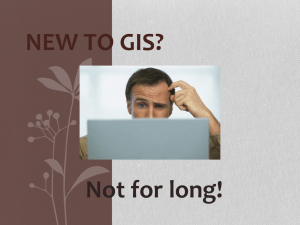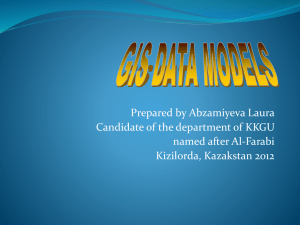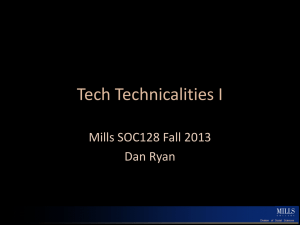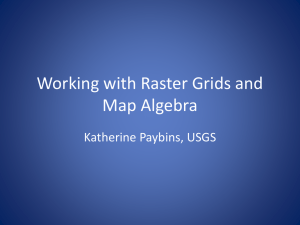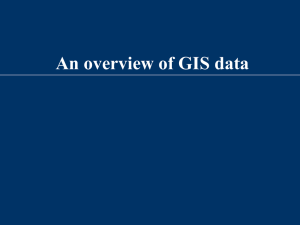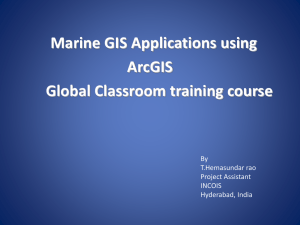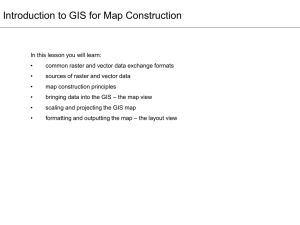Final Presentation
advertisement
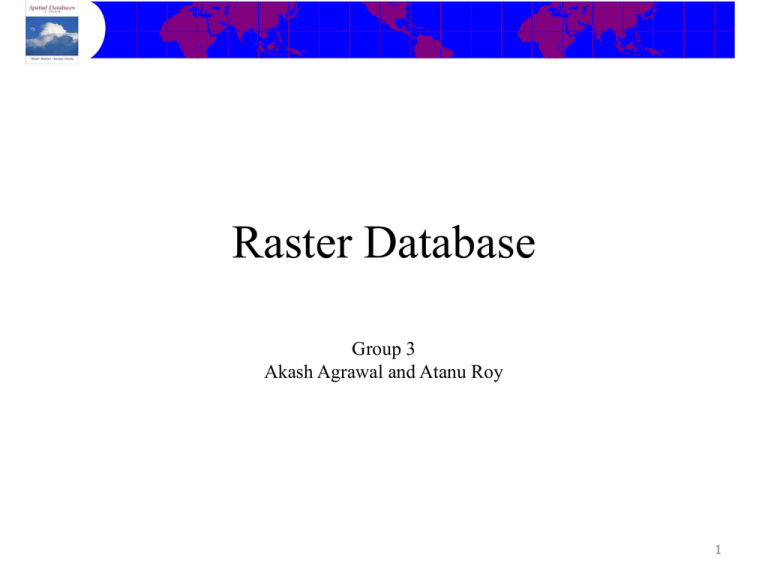
Raster Database Group 3 Akash Agrawal and Atanu Roy 1 Chapter Organization • 1.1 Raster Data • 1.2 Raster Data in GIS – – – – 1.2.1 Spatio-Temporal Data 1.2.2 Field Operations 1.2.3 Storage 1.2.4 Retrieval Techniques • 1.3 Concluding Remarks 2 Learning Objectives • Learning Objectives (LO) – LO1 : Learn about Raster Data – LO2 : Learn about GIS Raster Database • • • • • Why use Raster data in GIS? How Spatio-temporal data is represented? What are different Field operations? What are different Storage techniques? What are different Retrieval Techniques? • Mapping Sections to learning objectives – LO1 – LO2 - 1.1 1.2 3 Raster Data • • • • A raster image is rows and columns of cells organized in a rectangular grid. Each cell is called a Pixel. Each pixel stores a singular color/attribute value. Resolution of rater image is denoted by #pixels in row X #column of the grid. – 800X600 resolution denotes that the raster image contains 600 rows of 800 pixel each. 4 Learning Objectives • Learning Objectives (LO) – LO1 : Learn about Raster Data – LO2 : Learn about GIS Raster Database • • • • • Why use Raster data in GIS? How Spatio-temporal data is represented? What are different Field operations? What are different Storage techniques? What are different Retrieval Techniques? • Mapping Sections to learning objectives – LO1 – LO2 - 1.1 1.2 5 Raster Data in GIS • The primary purpose is to display the detailed image on a map area or render its identifiable objects by digitization. • Raster maps are ideally suited for mathematical modeling and quantitative analysis. • Data storage techniques data are easy to program and gives good performance for data retrieval. • Commonly used form of raster data in the field of GIS – aerial photographs of some area. • Other raster datasets used in GIS – – – – a digital elevation model Map of reflectance of a particular wavelength of light. Landsat Electromagnetic spectrum indicators 6 Learning Objectives • Learning Objectives (LO) – LO1 : Learn about Raster Data – LO2 : Learn about GIS Raster Database • • • • • Why use Raster data in GIS? How Spatio-temporal data is represented? What are different Field operations? What are different Storage techniques? What are different Retrieval Techniques? • Mapping Sections to learning objectives – LO1 – LO2 - 1.1 1.2 7 How Spatio-Temporal data is represented? • The ST data has become crucial – to understand cause and effect scenarios – development of dynamic models for the analysis of it. • The Snapshot Model – Every layer in the snapshot model shows the state of geographic distribution at one time stamp. – Time intervals between any two layers may vary – There is no explicit implication for changes within the time lag of any two layers. 8 Learning Objectives • Learning Objectives (LO) – LO1 : Learn about Raster Data – LO2 : Learn about GIS Raster Database • • • • • Why use Raster data in GIS? How Spatio-temporal data is represented? What are different Field operations? What are different Storage techniques? What are different Retrieval Techniques? • Mapping Sections to learning objectives – LO1 – LO2 - 1.1 1.2 9 Field data • Field data are an essential part of GIS systems. – give most up-to-date information about current events – Needed for creating/updating digital maps – Help in validating the available data sets. • Field data source – Satellites – Geo-registered sensor networks etc. • Field data set example – Satellite images, aerial photographs – Digitized paper maps – Earth Science data-sets, e.g. rainfall, temperature maps 10 Field operations • Field data can be manipulated using – Map algebra – Image algebra • Map algebra vs. Image algebra – Similarity: • Operand: raster data – Difference: • Image algebra deals with image properties such as color information, number of pixel, pixel size etc. Example trim/crop, zoom in/out etc. • Map algebra deals with attribute maps such as temperature map, vegetation map etc. Example thresholding, gradient etc. 11 Map Algebra • Map algebra – Operand: raster data – Operation: classified in four groups • Local, focal, global and zonal • Local operation: – The value of a cell in the new raster is computed only using the value of that cell in the original raster. – Example thresholding, point wise addition etc. Figure: An example thresholding with threshold value of 4 12 Map Algebra (Cont…) • Focal operation: – The value of a cell in the new raster is computed using the value of that cell and its neighboring cells in the original raster. – Example focal sum, gradient etc. Figure: An example of focal operation. (a) Rook neighborehood. (b) Bishop neighborehood. (c) Queen neighborehood. (d) Focal sum using queen neighborehood. 13 Map Algebra (Cont…) • Global operation: – The value of a cell in the new raster is computed using the location or values of all cells in the original raster data. – Example: global sum, global average etc. • Zonal operation – the value of a cell in the new raster is a function of the value of that cell in the original raster and the values of other cells which appear in the same zone specified in another raster. – Example distance from nearest facility. 14 Image Algebra • Map algebra – Operand: raster data/ Image – Operation: • ignores the absolute location of pixels. • come from image processing literature. • used for display or rendering the image for manual analysis of demonstration purpose. • Example: trim/crop, zoom in/out, rotate etc. Figure: An example trim operation. 15 Learning Objectives • Learning Objectives (LO) – LO1 : Learn about Raster Data – LO2 : Learn about GIS Raster Database • • • • • Why use Raster data in GIS? How Spatio-temporal data is represented? What are different Field operations? What are different Storage techniques? What are different Retrieval Techniques? • Mapping Sections to learning objectives – LO1 – LO2 - 1.1 1.2 16 Storage Techniques • Traditional Approach – – – – standard file-based structure of TIF, JPEG, etc. use custom software to retrieve data-items of interest Pros: provide good compression and require less storage space. Cons: difficult to index the data and hence has slower retrieval operation. • Database Approach – stores the raster data items attributes such as geo-location, time-stamp, various properties etc. in database tables. – Use database query language such as SQL to retrieve data-item of interest. – Pros: • allows quicker retrieval of the raster data. • allows user defined attributes and support for ad-hoc queries. – Cons: require storage of millions of significantly sized records. 17 Learning Objectives • Learning Objectives (LO) – LO1 : Learn about Raster Data – LO2 : Learn about GIS Raster Database • • • • • Why use Raster data in GIS? How Spatio-temporal data is represented? What are different Field operations? What are different Storage techniques? What are different Retrieval Techniques? • Mapping Sections to learning objectives – LO1 – LO2 - 1.1 1.2 18 Retrieval Techniques • Raster data sets are very rich in content • Retrieval approaches – Meta-data approach (database approach) – Content based retrieval (image processing technique) • Meta-data approach – stores values of descriptive attributes for each raster data item. – uses simpler SQL data types such as numeric, string, date etc. – queries to select a set of descriptive attributes such as location, time-stamp, subject etc. – Pros: • Simpler to implement • gives accurate answers for queries to select a set of descriptive attributes. – Cons: • Queries are limited to descriptive attributes. • does not support “similarity” based queries 19 Retrieval Techniques (Cont…) • Content based retrieval or content based image retrieval (CBIR) – content of an image is represented by extracted primitive visual features such as representing color, shape and texture. – Similar image queries are answered based on some combination of these primitive features. – CBIR is a two step approach • Step 1: compute a feature vector or attribute relation graph (ARG) for each image in the database. • Step 2: given a query image, compute its ARG and compare to the ARGs in the database for the image most similar to the query image. – The success of this approach depends on efficiency of feature and similarity measure, used to compare two ARGs. 20 21

